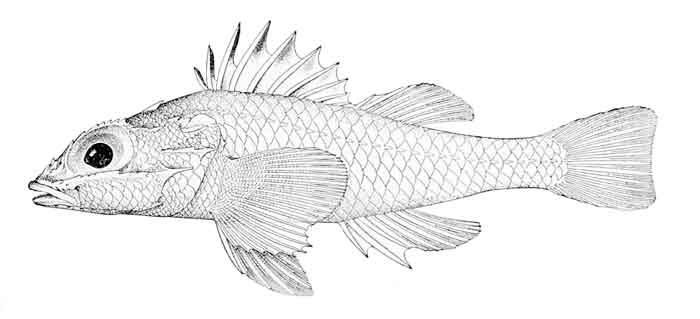Superregnum: Eukaryota
Cladus: Unikonta
Cladus: Opisthokonta
Cladus: Holozoa
Regnum: Animalia
Subregnum: Eumetazoa
Cladus: Bilateria
Cladus: Nephrozoa
Superphylum: Deuterostomia
Phylum: Chordata
Subphylum: Vertebrata
Infraphylum: Gnathostomata
Megaclassis: Osteichthyes
Superclassis/Classis: Actinopterygii
Classis/Subclassis: Actinopteri
Subclassis/Infraclassis: Neopterygii
Infraclassis: Teleostei
Megacohors: Osteoglossocephalai
Supercohors: Clupeocephala
Cohors: Euteleosteomorpha
Subcohors: Neoteleostei
Infracohors: Eurypterygia
Sectio: Ctenosquamata
Subsectio: Acanthomorphata
Divisio/Superordo: Acanthopterygii
Ordo: Scorpaeniformes
Subordo: Scorpaenoidei
Familia: Plectrogeniidae
Genus: Plectrogenium
Species (2): P. barsukovi – P. nanum
Name
Plectrogenium Gilbert, 1905: 634
Type species: Plectrogenium nanum Gilbert, 1905, by monotypy.
References
Primary references
Gilbert, C.H. 1905. II. The deep-sea fishes of the Hawaiian Islands. In: The aquatic resources of the Hawaiian Islands. Bulletin of the U. S. Fish Commission 23(pt 2): 577–713, pls. 66–101.

Plectrogenium nanum
Plectrogenium, is a genus of marine ray-finned fishes, the stinger flatheads, the only genus classified within the subfamily Plectrogeninae, which in turn is classified within the family Scorpaenidae. This genus is found in the Indian and Pacific Oceans.
Taxonomy
Plectrogenium was originally named as a monotypic genus in 1905 by the American ichthyologist Charles Henry Gilbert when he described what was then considered to be its only species,[1] Plectrogenium nanum, from Hawaii.[2] Plectrogenium is the only genus in the monotypic subfamily Plectrogeninae which is classified within the family Scorpaenidae in the order Scorpaeniformes by some authorities.[3] Other authorities treat this taxon as part of a separate family Plectrogenidae, alongside the genus Bembradium, and place this family in the perciform suborder Platycephaloidei.[4] The genus name, Plectrogenium, is a compound of plectro, which means “spur”, and genys, which means “cheek”or “chin”, an allusion to the lines of robust spines along the sides of the head.[5]
Species
The currently recognized species in this genus are:[1]
Plectrogenium barsukovi Mandritsa, 1992
Plectrogenium capricornis Matsunuma, Uesaka, Yamakawa & Endo, 2021
Plectrogenium kamoharai Uesaka, Yamakawa, Matsunuma & Endo, 2021
Plectrogenium kanayamai Uesaka, Yamakawa, Matsunuma & Endo, 2021
Plectrogenium longipinnis Matsunuma, Uesaka, Yamakawa & Endo, 2021
Plectrogenium megalops Matsunuma, Uesaka, Yamakawa & Endo, 2021
Plectrogenium nanum C. H. Gilbert, 1905
Plectrogenium occidentalise Matsunuma, Uesaka, Yamakawa & Endo, 2021
Plectrogenium rubricauda Matsunuma, Uesaka, Yamakawa & Endo, 2021
Plectrogenium serratum Matsunuma, Uesaka, Yamakawa & Endo, 2021
Characteristics
Plectrogenium is characterised by having a laterally compressed body with a number of spines and ridges on the head. There are venom glands on the spines in the dorsal, anal and pelvic fins.[6] The dorsal fin typically has 12 spines and 71/2 soft rays, the dorsal fin is split into 2 fins with 2 spines in the anterior part of the second dorsal fin. There are between 22 and 25 rays in the pectoral fins and they have 30-35 vertical rows of ctenoid scales on the body. There are flattened spines on the suborbital ridge which resembles that of the Platycephalidae. The mouth is positioned ventrally.[7] They are small fishes with standard lengths of less than 10 cm (3.9 in)[8]
Distribution and habitat
Plectrogenium is found in the Indian and Pacific Oceans from Madagascar to Hawaii.[9] They are bathydemersal fishes which are found at depths greater than 250 m (820 ft).[6]
References
Eschmeyer, William N.; Fricke, Ron & van der Laan, Richard (eds.). "Genera in the family Plectrogeniidae". Catalog of Fishes. California Academy of Sciences. Retrieved 18 April 2022.
Eschmeyer, William N.; Fricke, Ron & van der Laan, Richard (eds.). "Species in the genus Plectrogenium". Catalog of Fishes. California Academy of Sciences. Retrieved 18 April 2022.
J. S. Nelson; T. C. Grande; M. V. H. Wilson (2016). Fishes of the World (5th ed.). Wiley. pp. 468–475. ISBN 978-1-118-34233-6.
Ricardo Betancur-R; Edward O. Wiley; Gloria Arratia; et al. (2017). "Phylogenetic classification of bony fishes". BMC Evolutionary Biology. 17 (162): 162. doi:10.1186/s12862-017-0958-3. PMC 5501477. PMID 28683774.
Christopher Scharpf & Kenneth J. Lazara, eds. (7 December 2021). "Order PERCIFORMES: Suborder PLATYCEPHALOIDEI: Families BEMBRIDAE, PARABEMBRIDAE, PLATYCEPHALIDAE, HOPLICHTHYIDAE and PLECTROGENIIDAE". The ETYFish Project Fish Name Etymology Database. Christopher Scharpf and Kenneth J. Lazara. Retrieved 18 April 2022.
Froese, Rainer; Pauly, Daniel, eds. (February 2022). "Family Plectrogeniidae - Stinger flatheads". FishBase. Retrieved 18 April 2022.
William N. Eschmeyer and John E. Randall (1975). "The Scorpaenid Fishes of the Hawaiian Islands Including New Species and New Records (Pisces:Scorpaenidae)". Proceedings of the California Academy of Sciences. Series 4. 40 (11): 265–334.
Froese, Rainer; Pauly, Daniel (eds.). "Species in genus Plectrogenium". FishBase. February 2022 version.
Matsunuma, M.; Uesaka, K.; Yamakawa, T. & Hiromitsu Endo (2022). "Review of the Indo-Pacific scorpaenoid genus Plectrogenium Gilbert 1905 (Plectrogeniidae) with descriptions of eight new species". Ichthyological Research. 69 (3): 299–351. doi:10.1007/s10228-021-00844-z.
Retrieved from "http://en.wikipedia.org/"
All text is available under the terms of the GNU Free Documentation License

